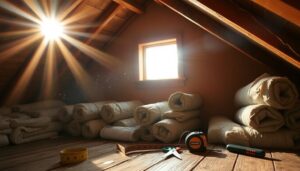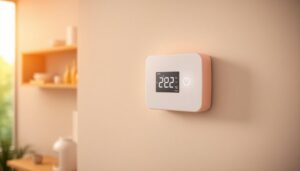Using moisture barriers for your click-and-lock flooring is essential for saving money and preventing issues down the line. These barriers protect your flooring from water vapor, especially in high-humidity areas like basements. They help avoid mold growth and expensive repairs while extending the life of your investment. With several types available, including coatings and sheets, you can choose the best fit for your needs. Proper installation and regular inspections will guarantee your moisture barrier remains effective. If you want to discover more about the best options and installation tips, there's plenty more to explore.
Understanding Moisture Barriers
Moisture barriers are essential for protecting your flooring from potential damage, especially in areas prone to high humidity like basements.
A moisture barrier, or vapor barrier, plays a fundamental role in flooring installations by preventing water vapor from seeping into your flooring materials. This is particularly important because concrete slabs can have moisture content levels that reach 19%. Accurate categorization of moisture barriers can enhance their effectiveness in protecting your flooring. Additionally, implementing good practices in expense management apps can help you budget for necessary materials and installations effectively.
Without a proper barrier, you risk promoting mold and mildew growth, which can greatly impact your indoor air quality.
Understanding the types of moisture barriers is critical for selecting the right one for your project. Class I barriers offer the strongest protection against moisture intrusion and are particularly beneficial for flooring longevity.
It's also important to make certain that when you install the moisture barrier, it's sealed properly and free of any punctures. This continuity is key to maintaining its effectiveness over time. Additionally, selecting the right barrier can also contribute to sustainable consumption patterns, as it ensures you're using materials that are effective and environmentally friendly.
Types of Moisture Barriers
When you're selecting moisture barriers for your flooring, you'll find a variety of options to choose from.
Coating options, like Wakol PU 280, can provide a seamless protective layer, while sheet barriers offer additional benefits by preventing water intrusion. Understanding these choices will help you make the best decision for your specific flooring needs. Additionally, considering sustainable packaging solutions can enhance your overall eco-friendliness during the installation process. Choosing eco-friendly materials can also contribute to reducing carbon emissions, promoting a healthier environment. Furthermore, using materials like Econyl can help combat environmental issues while ensuring durability in your flooring project.
Coating Options Available
Choosing the right coating option for your flooring can greatly impact its resistance to moisture. Rolled-on liquid coatings, like Wakol PU 280, create a robust protective layer on subfloors, effectively acting as moisture barriers for your click-and-lock flooring installations.
These coatings are designed for compatibility with various flooring types, including laminate and luxury vinyl planks, guaranteeing enhanced moisture resistance while preserving the integrity of your setup.
Products such as Bostik GreenForce take this a step further by offering integrated moisture control membranes that can be directly applied beneath your flooring. This integrated approach simplifies the moisture management process, providing peace of mind.
When it comes to the application method, coating moisture barriers are typically straightforward to apply. Just make sure your surface is clean and dry, and allow the coating to cure fully before proceeding with the flooring installation.
This guarantees peak performance and long-term protection against mold and water damage. By choosing the right coating options, you're not just protecting your investment; you're also enhancing the longevity and durability of your flooring for years to come.
Sheet Barrier Benefits
Effective moisture management is crucial for maintaining the integrity of your flooring, and sheet barriers offer a dependable solution. Made from materials like plastic or foil, these moisture barriers are particularly effective when installed over concrete subfloors, which can allow water intrusion due to their porous nature. By preventing moisture damage, sheet barriers protect your flooring materials from potential mold growth and structural issues.
During your flooring installation, be sure to overlap seams by at least six inches and seal them properly. This guarantees a continuous moisture barrier that maximizes protection.
Additionally, sheet barriers can be combined with other types of underlayment. This combination not only enhances moisture protection but also provides added insulation, cushioning, and sound absorption.
Using sheet barriers correctly contributes to the longevity of your flooring and greatly improves indoor air quality by minimizing moisture-related problems.
Importance of Moisture Barriers
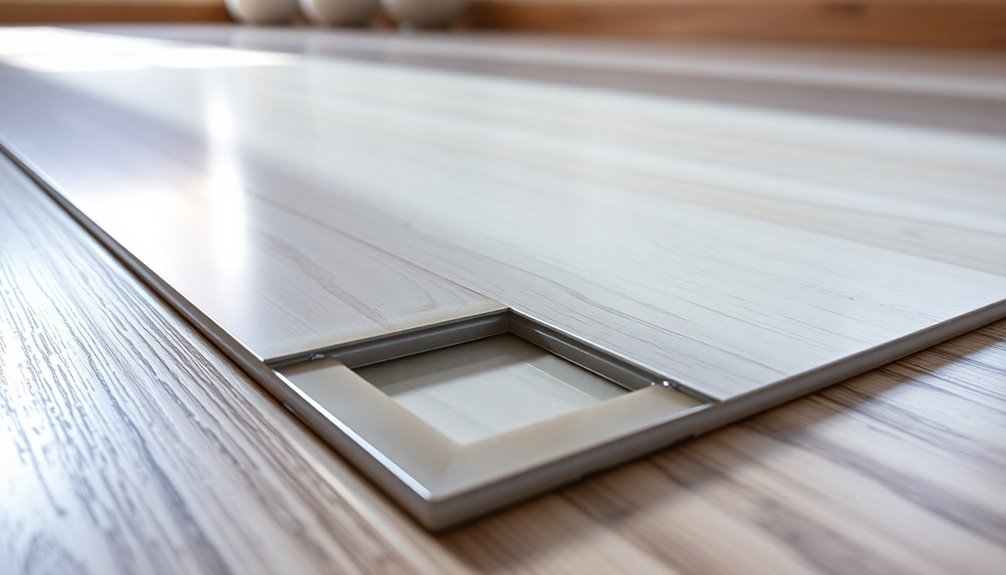
Moisture barriers are essential for protecting your flooring investment, especially in areas where water intrusion is a concern. When you install laminate flooring over concrete subfloors, moisture levels can reach up to 19%, making the use of a moisture barrier critical. These barriers act as a shield, preventing moisture from seeping through and causing mold growth, wood rot, or cupping in your flooring materials. In high humidity environments or damp areas, a moisture barrier is even more important for effective moisture control. Investing in a quality moisture barrier not only protects your flooring but also enhances your overall financial well-being by preventing costly repairs.
It not only safeguards your flooring but also helps maintain indoor air quality. If moisture-related issues arise, you could face costly repairs that could have been avoided with proper installation of a moisture barrier. Regular reviews of savings and investment performance support informed decision-making, including identifying potential moisture-related expenses. Implementing clear payment terms can also help in managing such investments efficiently.
To maximize the effectiveness of your moisture barrier, guarantee you seal seams and maintain continuity throughout the installation. This attention to detail will enhance the longevity and durability of your laminate flooring. Investing in a quality moisture barrier protects your flooring investment and saves you money in the long run by preventing potential problems due to moisture intrusion.
Installation Best Practices
Proper installation of moisture barriers is vital for guaranteeing your flooring performs well over time. Start by making certain your subfloor is clean, dry, and level. This step prevents issues with your click-and-lock flooring system and maintains a smooth finish.
When you install the moisture barrier, overlap the seams by at least six inches and use seam tape to seal them. This creates a continuous barrier against moisture intrusion. Additionally, using budgeting apps can help you plan for the costs associated with installing moisture barriers. Establishing a budget through effective management can also ensure you allocate funds appropriately for this essential step.
Remember to use an underlayment installed on top of the moisture barrier. This not only provides additional protection but also enhances comfort underfoot. It's important to follow the manufacturer guidelines regarding the specific type of moisture barrier needed for your flooring material. This guarantees warranty compliance and peak performance.
One common mistake to avoid is sealing the moisture barrier directly to concrete; doing so can trap moisture and lead to issues later.
After installation, regularly inspect the area for signs of moisture accumulation or damage. Early detection can save you from costly repairs and help guarantee your flooring lasts for years to come. Additionally, consider using expense tracking tools to manage any associated costs effectively.
Following these best practices will set you up for success with your new flooring.
Flooring Compatibility Considerations
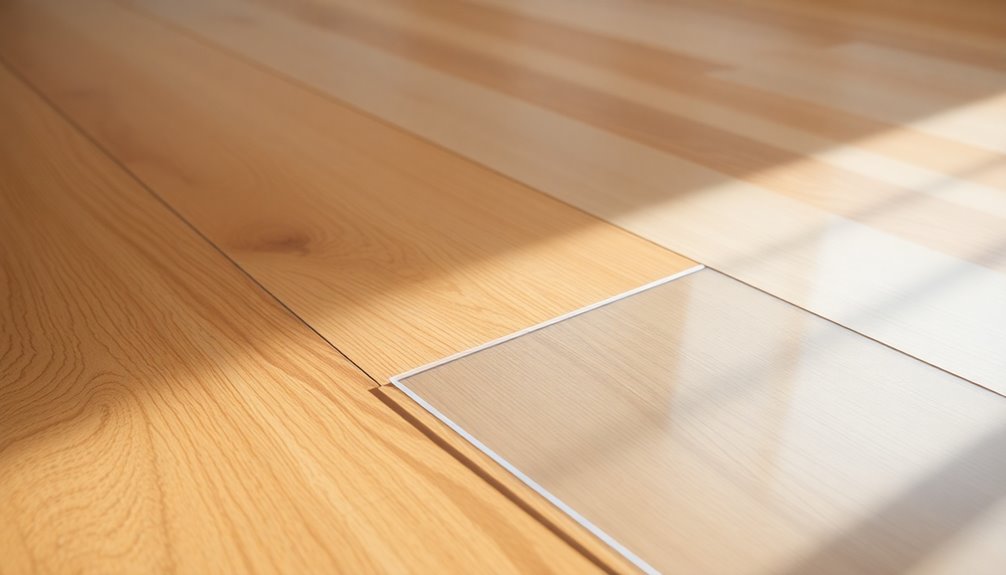
When choosing flooring, you need to take into account the type and its moisture resistance requirements.
Different materials, like laminate or bamboo, react uniquely to moisture, so it's essential to assess your installation environment. Additionally, understanding the price comparison tools available can help you find the most cost-effective options for moisture-resistant flooring. Utilizing price comparison accuracy features ensures that you are making informed purchasing decisions based on real-time data. Moreover, leveraging effective use of these tools can significantly stretch your budget and lead to smarter spending habits.
Flooring Types Overview
Choosing the right flooring type for your space involves understanding how different materials respond to moisture and humidity. For instance, laminate and luxury vinyl flooring (LVP) are popular choices, especially in humid climates.
However, both require a moisture barrier when installed over concrete subfloors to prevent water damage and mold growth.
When you select laminate flooring, look for options with a foam underlayment that includes a built-in moisture barrier. This is crucial for areas prone to high humidity or moisture exposure.
Engineered hardwood flooring also needs a moisture barrier in high-moisture environments to guard against cupping and warping, thanks to wood's hygroscopic nature.
If you're considering bamboo hardwood, it mightn't require an additional barrier when glued down, but you should assess specific moisture conditions to guarantee it performs well over time.
Always check the manufacturer guidelines for the specific moisture barrier requirements of your chosen flooring type. This guarantees you maintain warranty compliance and achieve peak performance, particularly if you're working with a plywood subfloor that may not handle moisture effectively.
Moisture Resistance Requirements
Understanding moisture resistance requirements is vital for guaranteeing your flooring choice performs well in your specific environment. When installing flooring over concrete subfloors, a moisture barrier is often a must, especially in high humidity areas or basements.
The type of flooring you choose will dictate the moisture barrier needed; for instance, laminate flooring typically requires a moisture barrier, while luxury vinyl plank (LVP) may only need one in particularly moisture-prone settings.
It's important to evaluate the moisture resistance properties of each material. Some flooring options, like bamboo hardwood, mightn't need an extra barrier if installed correctly with adhesive.
By installing a moisture barrier, you can prevent issues like cupping and warping in wood-based flooring, enhancing durability and extending the lifespan of your installation.
When selecting a moisture barrier, consider its permeability classification. Products range from Class I to Class III, and you'll want to choose one that effectively controls moisture based on your specific installation conditions.
Paying attention to these moisture resistance requirements helps protect your investment and guarantees your flooring remains beautiful and functional for years to come.
Installation Environment Factors
Evaluating the installation environment is key to guaranteeing your flooring choice not only complements your space but also withstands the conditions it faces. When installing click-and-lock flooring, you need to assess the type of subfloor—be it concrete, plywood, or OSB. This assessment will determine if a moisture barrier is necessary to prevent moisture-related damage.
In high humidity environments, especially in basements or damp areas, using a moisture barrier is vital to mitigate risks of mold and water damage.
Selecting the right underlayment that includes a vapor barrier is fundamental when installing click-and-lock flooring over concrete, as it protects the flooring's integrity from moisture. Different flooring types, like laminate flooring and luxury vinyl, may have specific moisture barrier requirements.
For instance, laminate flooring typically requires a barrier when placed over concrete.
Always follow manufacturer recommendations regarding moisture barriers and underlayment compatibility. This not only guarantees the long-term performance of your click-and-lock flooring systems but also helps maintain any applicable warranties.
Troubleshooting Moisture Issues
Moisture issues can sneak up on you, and even small amounts can lead to serious problems like mold growth and structural damage. To catch these issues early, regularly inspect your flooring and subfloors. Look for signs like discoloration, warping, or a musty smell that might indicate moisture problems.
If you're dealing with high humidity, implementing humidity control methods is essential. Dehumidifiers and proper ventilation can greatly reduce moisture levels and help protect your flooring.
Don't hesitate to consult professionals if you're uncertain about structural concerns related to moisture. They can provide valuable insights and recommend timely interventions to prevent further damage.
When installing click-and-lock flooring, remember the importance of a moisture barrier. This barrier acts as a protective shield against vapor and moisture, ensuring the long-term performance and durability of your flooring.
Taking these proactive steps will help you troubleshoot moisture issues before they escalate, saving you time, money, and stress in the long run. With vigilance and the right measures in place, you can enjoy your flooring without the worry of hidden moisture problems.
Cost and Quality Insights
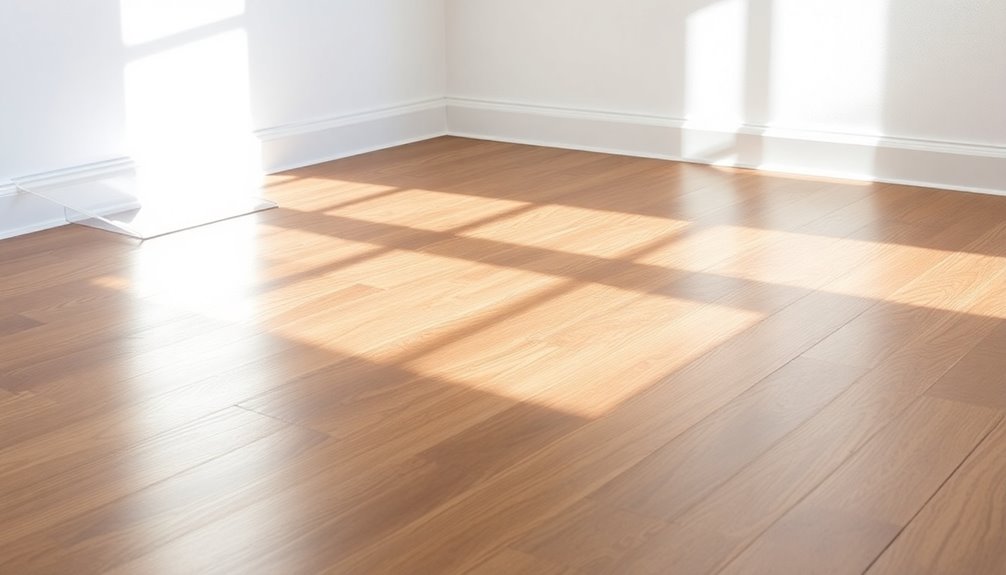
Investing in a high-quality moisture barrier for your click-and-lock flooring can save you money in the long run. The cost for quality moisture barriers typically hovers around $50 for 100 square feet. This price tag is a small price to pay considering the potential damage you could face without proper protection.
By choosing superior moisture barriers rated for vapor transmission control, you can greatly reduce long-term flooring expenses by minimizing risks like mold, wood rot, and other moisture-related issues that can lead to costly repairs.
Major retailers like Home Depot offer competitively priced options that outperform many alternatives on the market. This makes it easier than ever to access quality moisture barriers that guarantee your flooring lasts longer.
Additionally, utilizing a moisture barrier not only protects your investment but also enhances indoor air quality, providing added health benefits for your home.
Conclusion
In the end, think of moisture barriers like an umbrella on a rainy day; they protect your beautiful flooring investment from unexpected drips and dampness. Just as you wouldn't brave a storm without one, don't skip this essential step during installation. By choosing the right moisture barrier and following best practices, you can save money and avoid costly flooring issues down the line. Your floors deserve the best protection, so don't leave them out in the rain!


